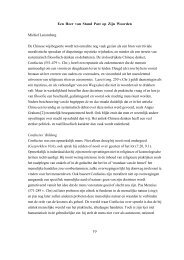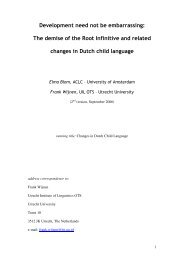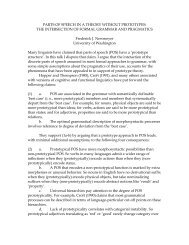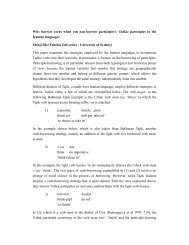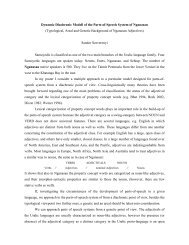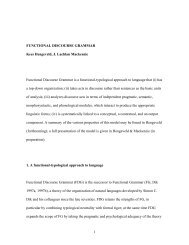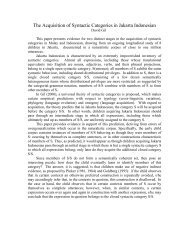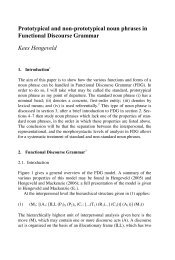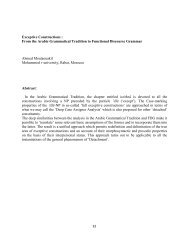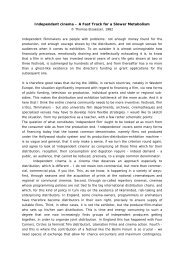The argument structure of deverbal nouns in Brazilian Portuguese
The argument structure of deverbal nouns in Brazilian Portuguese
The argument structure of deverbal nouns in Brazilian Portuguese
Create successful ePaper yourself
Turn your PDF publications into a flip-book with our unique Google optimized e-Paper software.
It is obvious that this type <strong>of</strong> non specification is not applied to<br />
nom<strong>in</strong>alizations. But, similarly, if two predications share the same participants,<br />
reference to them may be omitted <strong>in</strong> the dependent construction, as illustrated <strong>in</strong> (29b)<br />
Guugu Yimidhirr (Australian)<br />
(29)b Ngayu wawu-dgirr [mayi buda-nhu]<br />
1SG.NOM want-COM.ABS food.ABS eat-PURPV<br />
‘I want to eat food’ (Haviland 1979: 135 apud Crist<strong>of</strong>aro 2003: 78)<br />
This pr<strong>in</strong>ciple, also mentioned by Koptjevskaja-Tamm (1993), expla<strong>in</strong>s such<br />
cases <strong>of</strong> <strong>argument</strong> shar<strong>in</strong>g <strong>in</strong> nom<strong>in</strong>alizations as given <strong>in</strong> (29c).<br />
(29)c a caça que é o que <strong>of</strong>erec-e...<br />
the.F hunted that be.IND.PRS.3SG what <strong>of</strong>fer-IND.PRS.3SG<br />
um-a resist-ência (EF-SP-450)<br />
a-F resist-NMLZ<br />
‘the hunted... that is the one that <strong>of</strong>fers... some resistance<br />
<strong>The</strong>re are also cases <strong>in</strong> which the non-overtly <strong>argument</strong> is not semantically<br />
determ<strong>in</strong>ed by the predicate <strong>of</strong> the ma<strong>in</strong> clause. When the participants are<br />
semantically predeterm<strong>in</strong>ed, the speaker may omit reference to them, s<strong>in</strong>ce the<br />
correspondent semantic <strong>in</strong>formation can be <strong>in</strong>ferred from the subord<strong>in</strong>ation relation.<br />
However, when the participants are not predeterm<strong>in</strong>ed and there is no overt reference<br />
to them, there is no semantic means <strong>of</strong> recover<strong>in</strong>g the miss<strong>in</strong>g <strong>in</strong>formation. Example<br />
(30a) can be seen as an illustration <strong>of</strong> this type <strong>of</strong> non-overt <strong>argument</strong>.<br />
(30)a a preocup-ação central...v-ai s-er<br />
the.F concern-NMLZ ma<strong>in</strong> go.AUX-IND.PRS.3SG be-INF<br />
em torno d-a caça... (EF-SP-405:51)<br />
<strong>in</strong> around <strong>of</strong>-the.F hunted<br />
‘the central concern ... will be around the hunted’<br />
When we consider the preced<strong>in</strong>g context, given <strong>in</strong> (11a), here repeated as<br />
(30b), we f<strong>in</strong>d that the first <strong>argument</strong> is the prehistorical man mentioned before.<br />
(30)b tod-a e qualquer manifest-ação (...) v-ai<br />
every-F and each manifest-NMLZ go.AUX-IND.PRS.3SG<br />
t-er que est-ar necessariamente lig-ad-a...<br />
have-INF that be.DUR-INF necessarily l<strong>in</strong>k-PAST.PTCP-F<br />
a est-a preocup-ação vital d-o homem pré-histórico<br />
to this-F concern-NMLZ vital <strong>of</strong>-M man prehistorical<br />
de... se conserv-ar viv-o... (EF-SP-405:50)<br />
<strong>of</strong> REFL keep-INF alive-M<br />
‘every manifestation will have to be necessarily l<strong>in</strong>ked… to this vital concern <strong>of</strong> prehistorical<br />
man <strong>of</strong>... keep<strong>in</strong>g himself alive...’<br />
18




